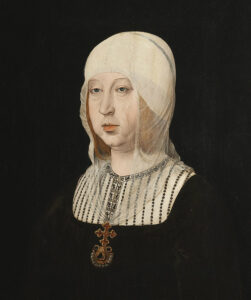Biographies of Spain’s Queen Isabel generally depict her extraordinary legacies in giving birth to both modern Spain (ruling Castile and Aragón jointly with her husband, Fernando, for decades and completing the Reconquista) and Spanish America, as well as the cruelties of her use of the Inquisition and expulsion of the Jews to Christianize her kingdoms.
Isabel is forty-seven at the outset of Isabel, Anacaona & Columbus’s Demise, with her domestic legacies largely behind her and suffering recurring illness. The book focuses on her governance of her conquerors in the Indies. During the period 1498–1502, she ordered and insisted that non-resisting “Indians” be treated as her vassals, neither enslaved nor abused, a perspective that was dismissed by most of her contemporaries.
The book cover illustrates Columbus’s enslavement and shipment to Spain of eight hundred Taíno Indians in 1498, and the narrative depicts Isabel’s furious reaction when the three hundred surviving the voyage arrived. Columbus’s disobedience to her became one of a number of factors in her decision to replace him as Española’s governor in 1500, and she manumitted these Indians—the mere nineteen then located and still surviving—and sent them back to Española with Columbus’s immediate successor, Francisco de Bobadilla. In 1501, she envisioned a coexisting Spanish-Indian society on Española without slavery and gave specific instructions to Bobadilla’s successor, Nicolás de Ovando, to reform her conquerors’ treatment to that end.
What happened—as the novel depicts—fell short of Isabel’s vision.
The first image is the famous portrait of Isabel painted between 1500 and 1504 by Juan de Flandes, one of two artists she commissioned to paint small panels (sometimes referred to as altarpiece paintings) portraying Christ’s important moments on earth set in Castilian settings. It’s exhibited in Madrid’s Palacio Royal. The second image is one of the Flandes panels, dated ca. 1502, depicting the Miracle of the Loaves and Fishes, in the same collection. Isabel appears therein, seated to Christ’s right, and some say the man standing behind her is King Fernando. Copies of both paintings are included in Isabel, Anacaona & Columbus’s Demise.


Find the full book description, advance reviews, and purchase links on my website www.andrewrowen.com
